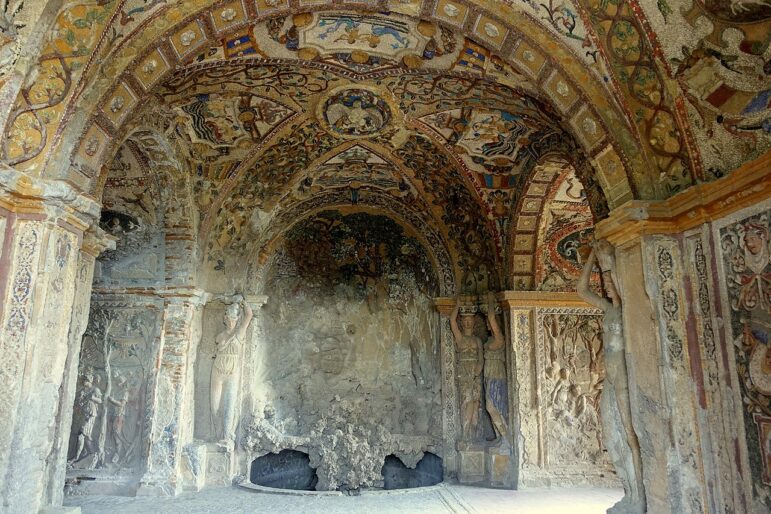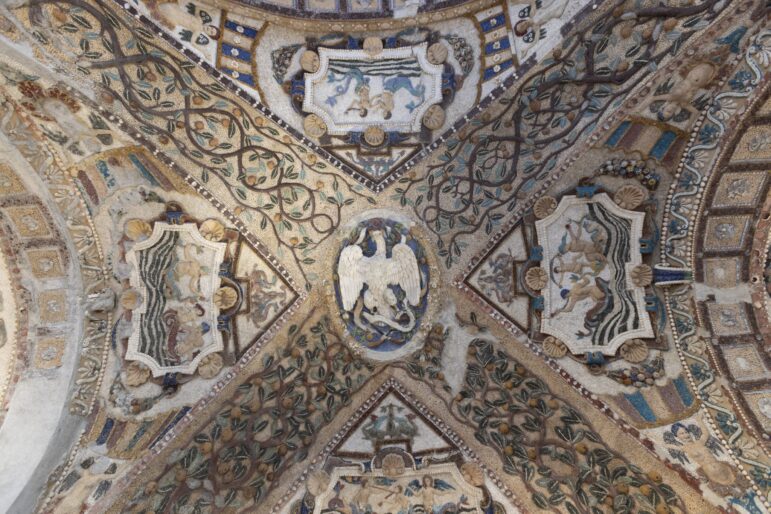
TIVOLI, Italy – The Villa d’Este is a sprawling Renaissance-era complex in Tivoli, not far from Rome, and has been a tourist destination for centuries. The Villa is now a museum operated by the Italian government, but it was originally built as a private residence for a man who spent his whole life expecting to be elected as Pope – which makes it rather intriguing that so much of his home was dedicated to the classical gods of the pagan era.
For 40 years, one of those shrines, the Grotto of Diana, has been closed to the public. The grotto’s features had suffered damage from time and traffic, with mosaic tiles decayed, statues damaged, and the ceramic floor dulled. But next month the grotto will reopen to the public at last, following a two year restoration funded by the luxury fashion house Fendi, as reported by Artnet News.

The Grotto of Diana at the Villa d’Este prior to restoration in 2019 [Daderot, Wikimedia Commons, public domain]
The Villa d’Este was constructed in the 16th century for Ippolito II d’Este, the second son of the Duke of Ferrara and the grandson of the Borgia Pope Alexander VI. Ippolito spent his entire life as a powerful member of the clergy; he was made the archbishop of Milan at the age of 10 and made a cardinal at the age of 30. He clearly expected to follow his grandfather’s example and became pope himself, and first stood for the position in 1549, at the age of 40. But while he had the support of the French king, the Habsburg Emperor had other ideas, and Ippolito had to stand down. (He would go on to run for the papacy four more times; he never succeeded.)
As compensation for his defeat, the College of Cardinals named Ippolito the governor of Tivoli. As governor, he had an official residence already, a former Benedictine convent, but it wasn’t nearly extensive enough for Ippolito’s tastes (or entourage.) In between various clerical scandals, lawsuits, and diplomatic affairs, Ippolito would order the creation of the Villa d’Este, which would continue to be built and expanded upon for the rest of his life, growing into a complex of 50 rooms decorated in brilliant frescoes. Its huge gardens were watered through an innovative hydraulic system. And much of the statuary and even more of the marble was looted from the ruins of the summer residence of the Roman Emperor Hadrian, which laid in the countryside near the Villa. Ippolito passed away in 1572, and his family eventually could not maintain the expenses of maintaining such a gargantuan estate, leading to its long decline.
Although Ippolito was a cardinal in the Catholic Church, the decoration of his estate showed a distinct preference for the pagan. While there is plenty of Christian imagery to be found, the halls dedicated to Noah and Moses stood alongside those dedicated to Venus and Hercules, and in the gardens there are fountains and statues retelling myths of Prosperpina, Pandora, and Neptune, along with several more depictions of Hercules. And underground lay the Grotto of Diana.

The ceiling of the Grotto of Diana at the Villa d’Este [Fendi]
As Artnet News writes:
Built by Paolo Calandrino between 1570 and 1572 […] the cross-shaped Grotto is ornately decorated with mosaics that portray mythological scenes. One side of the grotto serves as an antechamber and another leads to a covered terrace with views onto Rome.
At its center, below a vaulted ceiling, is a niche with a rocky backdrop that once housed a statue of the goddess—all such statues were sold in the 18th century and are now housed in the Capitoline Museum in Rome. Around the corners of this vault stand caryatids, a classical architectural feature of using female figures as architectural support. The walls of the grottos are decorated with a mosaic made up of shells, glass, and semi-precious stones, which have now been restored by hand. To prevent further degradation, a glass panel has been installed to protect the Grotto from wind.
Further attention was also given to the flooring which features terracotta tiles with motifs of eagles, Este lilies, and apples. Eagles and Este lilies were symbols connected to Ippolito’s family (a white eagle was in the coat of arms) and the apple is closely associated with Diana. The flooring is now ready to receive visitors who will be able to enjoy the Grotto on account of new lighting system that has been installed to create “a space of wonder and contemplation.”
Fendi, the fashion house that sponsored the restoration, is celebrating its own centennial this year. It has sponsored several other renovations in Italy in recent years, including six rooms at the Villa Medici. Fendi described the restoration of Diana’s Grotto as “an act of love.”
“The Grotto doesn’t just reopen as an architectural site,” said Andrea Bruciati, Director of the Autonomous Institute of Villa Adriana and Villa d’Este (VILLÆ), per DesignScene. “It re-emerges as a cognitive and aesthetic experience – one that invites new reflection on how space, time, and imagination connect.”
Although the statue of Diana herself may be long separated from the grotto, the prospect of visiting the newly-restored space within the Villa d’Este is sure to be enticing enough to convince many tourists in Rome to take a trip out to Tivoli. While their eyes trace the intricate mosaics depicting the classical myths, which lay not far, and in some cases right next to, depictions of familiar Christian figures like the Virgin Mary, we expect some will wonder about how a man who spent his life expecting to be pope would decide to spend so much time, money, and love on constructing such a tribute to pagan gods.
The Wild Hunt is not responsible for links to external content.
To join a conversation on this post:
Visit our The Wild Hunt subreddit! Point your favorite browser to https://www.reddit.com/r/The_Wild_Hunt_News/, then click “JOIN”. Make sure to click the bell, too, to be notified of new articles posted to our subreddit.
